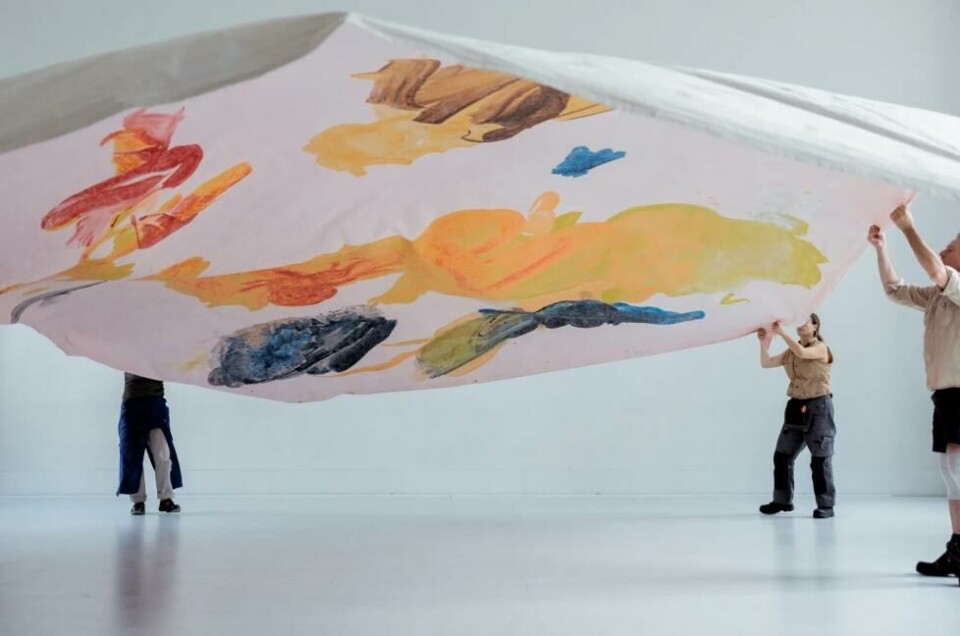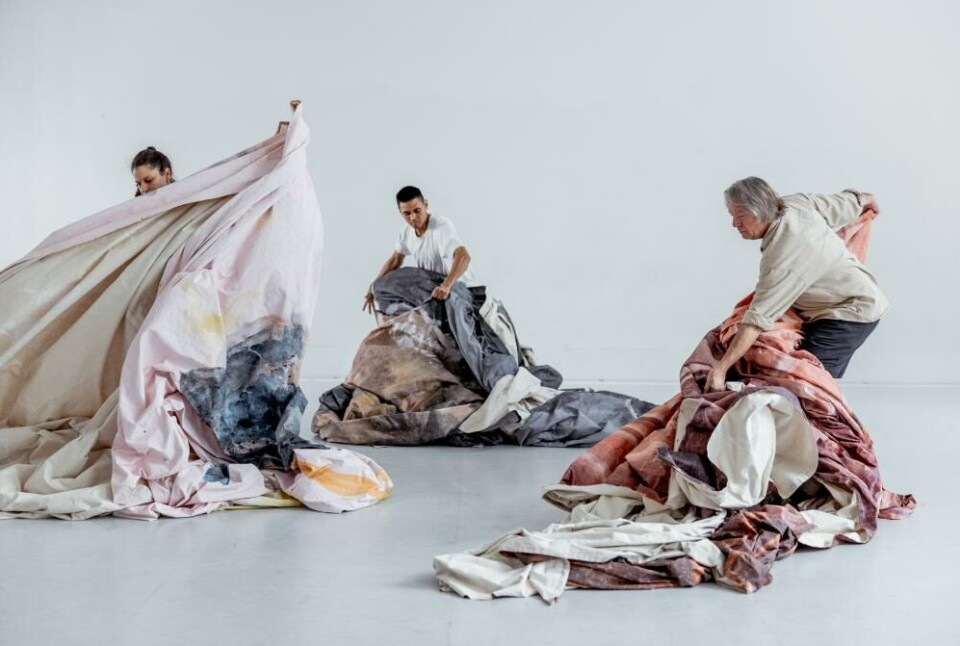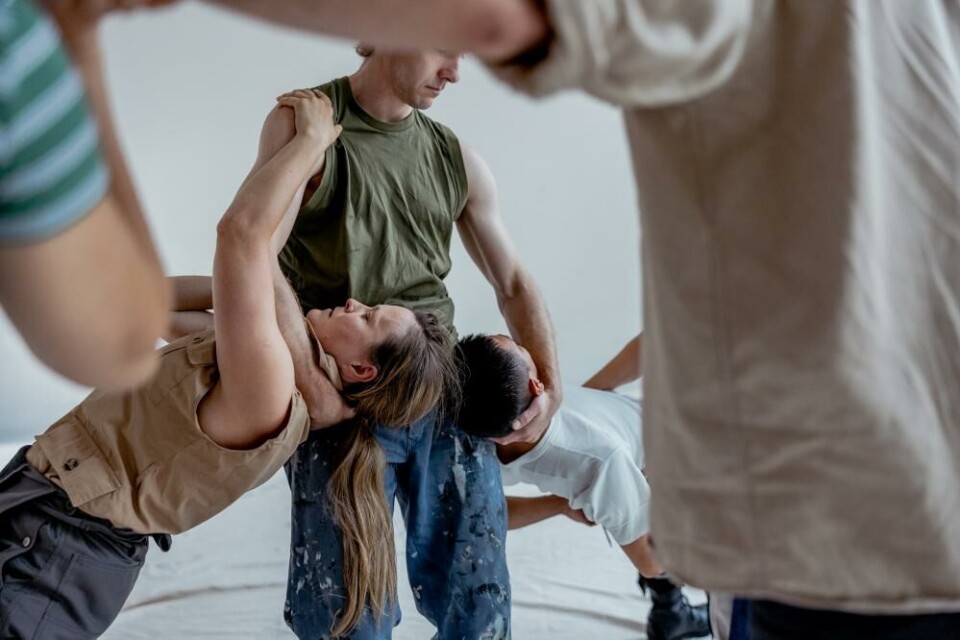
In the middle of the meaning
KNØ unfolds as an almost didactic study on the relationship between six bodies and three canvases and makes us aware of the joys of labour and the messy meaning of collectivity.
It has been a while since I have been in Gamle Munch. On arrival, I am reminded of the fact that Oslo city has not yet
found a concrete future for this beautiful building. I feel a little sad for the ‘old’ museum and how, once the Munch empire realized it had outgrown the space, they just ditched it. The empire is ruthless. In the meantime, Gamle Munch has to figure out its new mission, a kind of existential quest that often attracts art projects. KNØ, the second collaboration between the choreographers Ingeleiv Berstad and Pernille Holden, is one such project.
When we enter the former exhibition room, which is no longer an exhibition room, we are invited to take a seat on one of the chairs that form a diamond shape. The dancers, Terje Tjøme Mossige, Rina Rosenqvist, Mathias Aas Stoltenberg, Jens Jeffry Trinidad and Berstad and Holden are themselves present in the room and greet us casually and friendly. Their costumes, which carry references to professional working gear, give away the point of departure of KNØ, namely the interest in physical labour. Once we sit down, we watch the dancers set up the performative space by unfolding three pieces of big heavy canvas. When one of the canvases is lifted up in the air, we can see that on one side of it, there is a painting. As swiftly as the air of that gesture caresses us in the face, the colours of the paintings have already disappeared into the ground. What is left for us to see is only the back – a white surface with here and there a spot of paint, the unintentional traces that reminds us of the labour of painting.
To lean, to pull, to stretch, to drag
In 2018, Berstad and Holden made the duet Somatøs Samling which explored bodily fantasies and was presented in a shop space. KNØ echoes a continuity of previous interests, such as creating dance work that exists outside of the black box, an exploration of materials as texture, the use of simple actions while also attempting to expand the notions of authorship. Once the performative space of KNØ is set up, we notice how a couple of dancers start to lean into one another, finding points of contact between one body and the other. In different constellations (duo, trio, group), we can see the dancers exploring actions such as leaning, pulling, stretching, dragging, hanging, sliding, caressing, holding. It makes me think of a work of art that really touched me when I first saw it: Verb List (1967) by the American sculptor Richard Serra is a list of verbs describing «actions to relate to oneself, material, place, and process». To roll, to crease, to fold, to store, to bend, to shorten, to twist… It made me aware of how language can literally shape materials, make sculptures so to speak.
Gradually an atmospheric vocal soundtrack enters the space and we hear a repeating sound, a stern and persisting echo of a vowel. The dancers’ ways of approaching one another is quite gentle as if there is something intimate and precious at stake. At the same time, there seems to be a hesitation as if wanting to avoid defining clarity in the task.

After exploring these bodily relations, the dancers turn towards the canvas and begin to collect them. I think of the verb ‘to gather’ and how it resembles the word ‘together’. These actions, full of effort, are humorously encouraged by the other dancers, something that creates a rupture with the previous part. The sensuous sounds of the heavy textile makes me aware of the other materials in the space: the warm oiled wood on the walls, the cold shiny black stone floor, the white blinds and bright lights in the ceiling. Suddenly, I also notice how the door of the room is still open. Along the corridor I can see a patio with a little garden: the dark green summer leaves weighing down on branches, the little red dots which must be berries, a grey stone-like sculpture hiding under all of it. On the window, between ‘us here’ and ‘it over there’, I notice a million raindrops sticking to the glass. No rain will come in here.
Craftship
The canvases are actually part of Over Ævne, a performative project by the scenographer and visual artist Signe Becker in which she gave a group of theater painters precise instructions on how to paint her large canvases. I only learned this after having seen the performance. Even though KNØ is supported by Dansens Hus, there is unfortunately no podcast with additional information to contextualize the work. With her project, Becker (who is currently rounding up her PhD at Kunsthøgskolen in Oslo) wanted to raise questions about authorship and craftship by performing the tension between the signature artist and the people who actually execute the work. In that sense, the canvases and questions which resulted from Over Ævne, live on in KNØ, meeting the new context of dance and choreography, where the choreographer usually aligns with the author and the dancer with the craft(wo)manship.
After exploring ways of relating to and manipulating bodies, the dancers turn towards the canvas. There is something didactic about this step, but the process is nevertheless interesting to watch. I am especially intrigued by the few moments when the canvases appear to begin living their own life, becoming temporarily ‘animated beings’. It makes me attentive and curious to see if the manipulation of the matter will soon turn into an unexpected craft-like virtuosity. But KNØ doesn’t seem to be pulled by fictions or illusions and, like the weight of the canvases, fall back into the concrete.
‘I use that word all the time’
By attending to the physical labour surrounding the canvases, we now gradually see how the colours and some images, such as a knot and maybe a flower or a face, begin to appear. At some point, I wonder if this is what the performance will lead to: us watching the painting as a painting. The outcome must be in many minds when watching the process of unfolding. From order to chaos, and we go eventually back to order where all canvases are neatly folded and ready for the next performance. KNØ however surprises me with a long and slow ending, giving room for the labour to transform into something that feels like a ritual, or a joyous celebration of collective work. Knowing that KNØ is produced by Bananaz, an artist-led platform that supports collective forms of performance art-making, this emphasis makes a lot of sense.

Eventually, we listen as the dancers leave the room, their voices becoming faint in the distance – listening for what could be an end. As there are no theater lights to do it for us, we need to collectively decide that the performance is over. We look awkwardly around at our fellow audience members. Here and there a smile, and the question: who will break the ice? Then a decision is made: we begin our clapping.
‘Does KNØ mean anything?’ I am not sure if I know the answer even after having asked several Norwegian-speaking people over the weekend. Someone claimed it was made up, another person said it made them think of kneading, while yet another person said: ‘I use that word all the time’. According to this last person, the word is used in the North of Norway and means to be all over the place instead of doing the thing you are supposed to do. This makes me laugh, not only because that would be an unfairly harsh criticism of the performance, but also because I was convinced it meant ‘to knot’. I enjoy these kinds of conversations. Language is, afterall, a fun, if challenging field of collective negotiation. And somewhere there, KNØ has landed for me: softly in the middle of the meaning of all of it.
(Published 08.08.2023)
